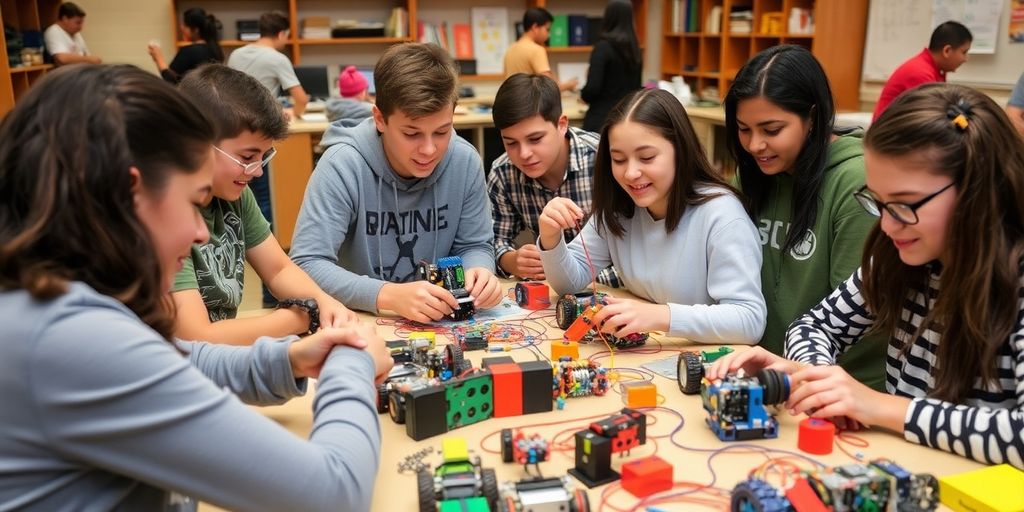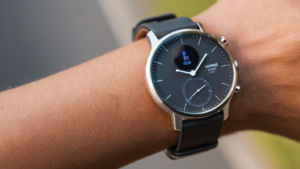So, you’ve got a teen who’s all about robots and AI? Awesome! Diving into AI science kits can be a game-changer for them. These kits are not just about fun; they’re a solid way to get hands-on with tech and learn a bunch of cool stuff. Whether they’re just starting out or already have some skills, there’s a kit out there that’s perfect. Let’s explore how these kits can turn your teen into a robotics whiz.
Key Takeaways
- AI science kits offer a practical way for teens to learn about robotics and programming.
- These kits cater to different skill levels, from beginners to advanced enthusiasts.
- Hands-on experience with these kits can enhance problem-solving and critical thinking skills.
- Robotics education can open up future career opportunities in tech fields.
- Engaging with robotics can also improve teamwork and collaboration among teens.
Exploring The Best AI Science Kits For Teens With Robotics
Top Features To Look For
When diving into the world of AI and robotics, especially for teens, it’s essential to know what features make a science kit stand out. Look for kits that offer a balance of building and coding opportunities. A good kit should include:
- Easy Assembly: Kits with clear instructions and components that snap or screw together without fuss.
- Programming Options: Whether it’s block-based coding for beginners or more advanced languages like Python, having coding flexibility is crucial.
- Sensor Integration: Kits that come with various sensors can simulate real-world robotics applications, enhancing the learning experience.
Benefits Of Robotics Education
Robotics education isn’t just about building cool machines. It provides a host of benefits:
- Improves Problem-Solving Skills: Teens learn to tackle complex problems by breaking them down into manageable parts.
- Encourages Creativity: Designing and programming robots allow teens to express their creativity in unique ways.
- Introduces STEM Concepts: Robotics naturally integrates science, technology, engineering, and math, making these subjects more engaging.
Engaging in robotics can transform a teen’s perspective on learning, making education feel less like a chore and more like an exciting adventure.
How To Choose The Right Kit
Picking the right robotics kit for your teen can be a bit overwhelming with so many choices out there. Here’s a simple guide:
- Assess Skill Level: Beginners might prefer kits with step-by-step tutorials, while more advanced teens could benefit from open-ended kits that challenge their creativity.
- Consider Interests: If your teen is interested in coding, look for kits that emphasize programming. For those who love building, kits with a variety of mechanical parts can be more appealing.
- Check for Expandability: Kits that allow for expansion with additional parts or integration with other technologies can grow with your teen’s skills.
For example, the Nous AI Robot is a great option for teens as it combines both building and coding, allowing them to create their own AI robot using Scratch and Python. This makes it ideal for those who are eager to learn both the mechanical and programming aspects of robotics.
Hands-On Learning Experiences With Robotics Kits

Building Your First Robot
Getting started with robotics is all about hands-on learning. The thrill of assembling your first robot is unmatched. Start simple: choose a kit that has clear instructions and all necessary parts. Here’s a basic checklist:
- Ensure the kit includes a step-by-step guide.
- Look for kits that provide all essential components.
- Consider the complexity level to match your skills.
Once you’ve got your kit, take your time with the build. It’s not just about putting pieces together; it’s about understanding how each component works in harmony. This foundational experience is crucial for diving deeper into more complex projects.
Programming Basics For Teens
After building, the next step is diving into robotic programming. It’s where the magic happens, turning a static model into a moving, responsive machine. Start with block-based coding platforms—they’re intuitive and perfect for beginners. As you get comfortable, transition to text-based languages like Python or Arduino IDE.
Here’s a simple progression path:
- Begin with block-based coding (Scratch or Blockly).
- Move to introductory text-based coding (Python).
- Explore advanced programming (Arduino, NodeJS).
Programming isn’t just about writing code; it’s about solving problems and thinking critically. As teens progress, they’ll learn to debug, optimize, and even create their own robotic functions.
Real-World Applications Of Robotics
Robotics isn’t just a hobby—it’s a gateway to understanding real-world applications. From automated manufacturing to healthcare robots, the skills learned through a robotics curriculum are directly applicable to various industries.
- Manufacturing: Robots are used for assembly lines and quality control.
- Healthcare: Assistive robots help in surgeries and patient care.
- Agriculture: Drones and robots monitor crops and manage resources.
By engaging with robotics kits, teens can explore these applications, sparking interest in potential career paths. The journey from building to programming and then to real-world application is a comprehensive learning experience that prepares them for future opportunities.
Robotics education is not just about creating machines; it’s about creating thinkers. The skills and mindset developed through robotics will serve teens well in any future endeavor.
For those looking to expand their experience, consider the Ozobot’s Evo Classroom Kit, which offers a robust platform for exploring STEM education with 18 robots included.
Innovative Robotics Kits That Inspire Creativity

Customizable Robot Designs
When it comes to robotics, flexibility in design is key. Kits like the Freenove Hexapod Robot offer an engaging way to explore robotics. This kit lets you build a robot that looks like a spider and can be controlled via various devices, providing a unique experience each time. The Kidwill 13-in-1 Solar Robot Kit is another great example, allowing teens to construct 13 different robots using solar power or batteries. These kits encourage creativity by offering multiple ways to assemble and customize robots.
Integrating AI Into Robotics
Integrating AI into robotics kits is becoming more common and opens up exciting possibilities. The Makeblock mBot Ultimate Robot Kit is designed for this purpose, allowing users to program robots using block-based coding or more advanced languages like Python. By experimenting with AI, teens can learn how robots can adapt and respond to their environment, making the learning process both interactive and educational.
Challenges And Competitions
Participating in robotics challenges and competitions can be a thrilling way for teens to apply what they’ve learned. Many kits are designed with this in mind, offering features that make them suitable for competitive environments. For example, the SunFounder Smart Video Car Robot Kit can be programmed to navigate complex courses, making it perfect for competitions. These events not only test a teen’s skills but also encourage teamwork and problem-solving.
Essential Skills Gained Through Robotics Education
Problem Solving And Critical Thinking
Robotics education is a fantastic way for teens to boost their problem-solving skills. When building and programming robots, they encounter challenges that require innovative solutions. Whether it’s figuring out why a sensor isn’t working or how to code a robot to perform a specific task, teens learn to approach problems methodically and creatively. This kind of critical thinking is invaluable and extends beyond robotics into everyday life.
Teamwork And Collaboration
In the world of robotics, teamwork is key. Many robotics projects involve working in groups, which helps teens learn how to collaborate effectively. They must communicate clearly, share ideas, and work together to achieve common goals. This experience is not just about building robots; it’s about building skills that are essential in any team-oriented environment.
Technical Skills Development
Robotics education offers hands-on experience with technology, which is a cornerstone of STEM learning. Teens gain practical skills in programming, engineering, and technology. They learn to use different coding languages, from block-based coding to languages like Python. This technical know-how is crucial as many future careers will demand such skills. Through educational robotics, teens are not just learning to build robots; they’re building a foundation for future success in the tech world.
Engaging with robotics isn’t just about constructing machines; it’s about constructing a mindset geared towards innovation and problem-solving. In today’s rapidly evolving tech landscape, these skills are not just desirable—they’re essential.
Popular Robotics Kits For Different Age Groups

Kits For Beginners
When it comes to introducing younger teens to robotics, simplicity and engagement are key. Robot educational toys like the Kidwill 13-in-1 Educational Solar Robot Kit offer a great start. This kit lets kids build 13 different solar-powered robots, sparking their curiosity without overwhelming them. Similarly, the 4M Kidzlabs Robotic Hand Kit is perfect for those new to robotics. It doesn’t require batteries, and the assembly is straightforward, making it a fun way to see if your teen is interested in robot building kits.
Here’s a quick look at some beginner-friendly options:
- Kidwill 13-in-1 Educational Solar Robot Kit: Build 13 different robots using solar energy.
- 4M Kidzlabs Robotic Hand Kit: Simple assembly with realistic gripping action.
- POKONBOY Building Blocks Robot Kit: Combines the fun of building blocks with robotics.
Intermediate Robotics Kits
For teens ready to tackle more complex projects, intermediate kits provide a balance of challenge and fun. The Lego robot kits are a fantastic choice, allowing older kids to create their own robots while encouraging creativity. These kits often come with coding instructions that use block-based programming languages, ideal for beginners transitioning to more advanced coding.
Other notable kits include:
- ELEGOO UNO R3 Project Smart Robot Car Kit: This kit introduces basic electronics and programming, offering modes like obstacle avoidance and line tracking.
- SunFounder Smart Video Car Robot Kit: A great add-on for those with a Raspberry Pi, featuring real-time camera feeds and Python programming.
- Meccano Meccanoid XL 2.0 Robot-Building Kit: With over 1,000 parts, this kit is perfect for those who love building and programming large robots.
Advanced Robotics Challenges
Older teens, aged 16-18, often look for kits that allow for customization and advanced programming. These kits often incorporate features like face recognition and voice commands, pushing the boundaries of what robotics for kids can achieve.
Consider these advanced options:
- Yahboom Raspberry Pi Robotic Car Kit: Offers impressive tasks with face and object recognition, programmable with Python.
- Petoi Bittle Robotic Dog: A compact but powerful robot dog that can be programmed with block-based coding or more advanced languages like C++.
- ELEGOO Mega 2560 Ultimate Kit: A comprehensive kit for those ready to dive into Arduino coding and complex robot designs.
Robotics kits offer a unique blend of learning and play, encouraging kids to explore engineering and programming in a hands-on way. Whether they’re just starting out or ready for advanced challenges, there’s a kit that can help them build, program, and explore the exciting world of robotics.
The Future Of Robotics And AI In Education

Emerging Technologies
In the fast-paced world of education, artificial intelligence and robotics are changing the way we learn. New technologies like machine learning are becoming part of classrooms, making lessons more interactive and fun. For example, AI can help teachers by grading papers or even creating personalized lessons for students. Robotics kits are also evolving, with more advanced features that let students experiment and learn how to build and program robots.
Career Opportunities In Robotics
As AI and robotics become more common, the demand for skilled workers in these fields is growing. Students who learn about these technologies in school have a head start on exciting careers. They can work in industries like manufacturing, healthcare, or even entertainment. Learning about AI and robotics isn’t just about getting a job; it’s about being part of the future.
The skills gained from robotics education are not just technical; they teach students how to think critically and solve problems, preparing them for a world where technology is everywhere.
The Role Of Robotics In STEM Education
Robotics plays a big part in STEM (Science, Technology, Engineering, and Math) education. It helps students understand complex concepts in a hands-on way. By building and programming robots, they learn about physics, math, and engineering. Plus, robotics encourages teamwork and creativity, which are important skills in any career.
- Robotics kits often include:
- Benefits of integrating robotics in education:
Educators are excited about these changes, but they also have concerns about the misuse of artificial intelligence by students. Balancing these technologies in education is key to maximizing their benefits.
Community And Resources For Young Robotics Enthusiasts
Online Forums And Support Groups
Getting into robotics can feel like stepping into a new world, but online forums and support groups can make it a lot easier. These platforms bring together enthusiasts from all walks of life, sharing tips, troubleshooting advice, and the latest trends. Whether you’re just starting or looking to refine your skills, these communities are gold mines of information. They offer a chance to ask questions, share your projects, and learn from others who share your passion for robotics.
Local Robotics Clubs
Joining a local robotics club is a fantastic way to meet people who love robots just as much as you do. These clubs often organize meetups, workshops, and even competitions, providing hands-on experience and a chance to showcase your creations. They are also a great way to learn about new tools and technologies. Many clubs collaborate with educational resources like InOrbit Robot Space to foster learning and innovation. Being part of a club not only improves your technical skills but also helps you develop teamwork and leadership abilities.
Workshops And Camps
For those who prefer a more structured learning environment, workshops and camps are perfect. They offer immersive experiences that can range from a few days to several weeks. These programs are designed to teach specific skills, whether it’s building a robot from scratch or learning to program using a new language. Camps, in particular, provide a unique opportunity to dive deep into robotics, often culminating in a project or competition. They are also a great way to make friends with similar interests, ensuring you have a support network as you continue to explore the world of robotics.
Robotics isn’t just about building machines; it’s about building a community. Engaging with others who share your interest can turn a solitary hobby into a shared adventure, full of learning and growth.
Conclusion
So, there you have it. These AI science kits are more than just a bunch of parts and wires. They’re like a gateway to the future for teens. Whether they’re building a robot car or programming a robotic arm, they’re not just having fun—they’re learning skills that could shape their careers. And even if they don’t end up in a tech job, the problem-solving and creativity they gain will stick with them. It’s like giving them a head start in life. So, why not let them dive into the world of robotics? Who knows, they might just become the next robot master.
Frequently Asked Questions
What is the best age to start learning robotics?
Kids can start learning robotics as early as 8 years old with simple kits. However, teenagers often benefit more as they can handle more complex tasks.
Do I need to know coding to build a robot?
Not always! Many beginner kits use block-based coding, which is easy to learn. As you advance, you might need to learn some programming languages like Python or C++.
What skills can teens gain from robotics?
Teens can learn problem-solving, teamwork, and technical skills. Robotics also helps them think critically and creatively.
Are robotics kits expensive?
The cost varies. Beginner kits can be affordable, while advanced kits with more features might be pricier. It’s important to choose one that fits your budget and needs.
Can robots really help in learning STEM?
Yes, robots make learning STEM fun and hands-on. They show how science, technology, engineering, and math work together in real life.
Where can teens find help if they get stuck?
Teens can join online forums, local clubs, or attend workshops and camps to get help and meet others interested in robotics.
Affiliate Disclaimer
This blog contains affiliate links. This means that if you click on a link and make a purchase, I may earn a small commission at no additional cost to you. These commissions help support the work and content I provide on this site.
I only recommend products and services that I genuinely believe will add value to my readers. However, please ensure that you do your own research and make informed decisions before purchasing any products or services mentioned here.
Thank you for your support!



